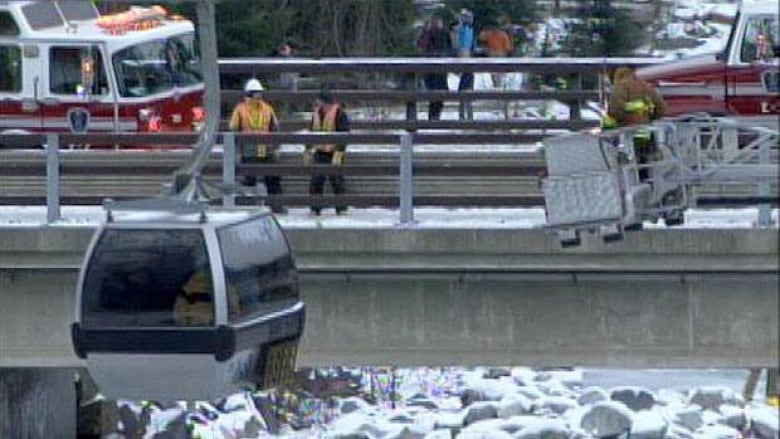Whistler gondola collapse blamed on ice

The final report into the 2008 collapse of a gondola tower at the Whistler-Blackcomb ski resort says ice was the reason for the collapse, but did not place any blame on individuals or organizations.
The report, which was issued bythe B.C. Safety Authority on Tuesday, contained six recommendations to preventa similar incident from happening in the future.
Thirteen people suffered minor injuries when a tower that supported the cables on the Excalibur Gondola partially collapsed, leaving 30 gondola cabins dangling from a thick metal cable.
Several cabins were damaged when they fell up to 10 metres to the ground, and one hit the roof of a bus shelter. Others remained suspended in the air. Remarkably, the most serious injury was a cracked vertebra.
According to Jason Gill, the B.C. Safety Authority's safety manager, water entered the tower's cavity, probably through a plate connecting the tower's upper and lower sections, and then froze after it was unable to drain out.
Water seeped in
"Tower No. 4 was designed by the manufacturer to be sealed to prevent water ingress and exposure to oxygen to inhibit corrosion of the inside of the tower tubes. However, over the 14 years since the Excalibur lift was installed, water did enter the tower inner cavity collecting in the lower section," said the report.
A rectangular opening on the plate used to pour concrete into the lower section during the tower's installation and a bolt hole cut with atorchwereboth believed to have provided a pathway for water to enter the tower.
Unusually cold temperatures in the Whistler area before the incident froze the water which had collected in the lower section of the tower. The ice then expanded inside the cavity, pushing against the walls and the plate, eventually causing the tower to collapse.
At the time of the collapse in December 2008,experts inspected the damaged tower and also concluded it was damaged by water expanding as it froze, resulting in what they called ice jacking.
Inadequate record keeping
The report did not blame human error for the failure, but did say that inadequate record keeping made it difficult to evaluate the effectiveness of the hammer blowtests normally used to check for water in the tower.
"The records of inspections carried out on Tower No. 4 and results of the resonance testing undertaken were vague making an accurate assessment of the reliability of the testing difficult," said the report.
The recommendation issued on Tuesday included that all ski hill towers must be fitted with drain holes to prevent water accumulation, better communication of safety procedures by manufacturers, and that safety bulletins are more closely followed and recorded by contractors.
The Excalibur Gondola, which runs from Whistler Village up Blackcomb Mountain, was built in 1994 by Austrian-based Doppelmayr and undergoes a safety check every year by the B.C. Safety Authority.












_(720p).jpg)


 OFFICIAL HD MUSIC VIDEO.jpg)
.jpg)



























































































